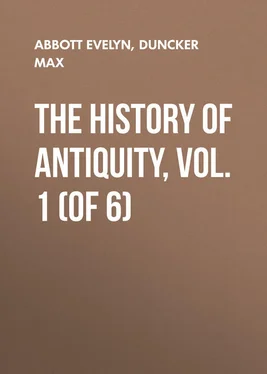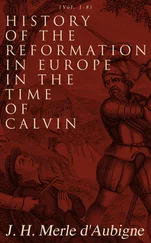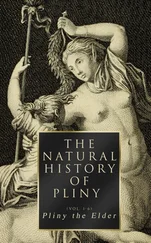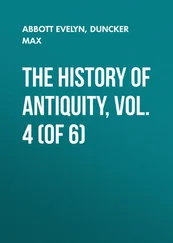Evelyn Abbott - The History of Antiquity, Vol. 1 (of 6)
Здесь есть возможность читать онлайн «Evelyn Abbott - The History of Antiquity, Vol. 1 (of 6)» — ознакомительный отрывок электронной книги совершенно бесплатно, а после прочтения отрывка купить полную версию. В некоторых случаях можно слушать аудио, скачать через торрент в формате fb2 и присутствует краткое содержание. Жанр: foreign_antique, foreign_prose, Историческая проза, на английском языке. Описание произведения, (предисловие) а так же отзывы посетителей доступны на портале библиотеки ЛибКат.
- Название:The History of Antiquity, Vol. 1 (of 6)
- Автор:
- Жанр:
- Год:неизвестен
- ISBN:нет данных
- Рейтинг книги:5 / 5. Голосов: 1
-
Избранное:Добавить в избранное
- Отзывы:
-
Ваша оценка:
- 100
- 1
- 2
- 3
- 4
- 5
The History of Antiquity, Vol. 1 (of 6): краткое содержание, описание и аннотация
Предлагаем к чтению аннотацию, описание, краткое содержание или предисловие (зависит от того, что написал сам автор книги «The History of Antiquity, Vol. 1 (of 6)»). Если вы не нашли необходимую информацию о книге — напишите в комментариях, мы постараемся отыскать её.
The History of Antiquity, Vol. 1 (of 6) — читать онлайн ознакомительный отрывок
Ниже представлен текст книги, разбитый по страницам. Система сохранения места последней прочитанной страницы, позволяет с удобством читать онлайн бесплатно книгу «The History of Antiquity, Vol. 1 (of 6)», без необходимости каждый раз заново искать на чём Вы остановились. Поставьте закладку, и сможете в любой момент перейти на страницу, на которой закончили чтение.
Интервал:
Закладка:
Still, from these accounts of Herodotus and Diodorus it is clear that the priests of Egypt possessed lists of the kings in long series, and that, according to their view, gods and demigods had ruled over Egypt for thousands of years before the earliest of these kings. After Greek princes had ascended the throne of the Pharaohs, and Egypt with its monuments and writings was opened to the research of the Greeks, Eratosthenes, who was the head of the library at Alexandria in the second half of the third century B.C., studied the history of these old kings – at "the royal request," as Georgius Syncellus tells us – in the old annals and lists of the Egyptians, and transcribed these lists in the Hellenic language. 12This compilation of Eratosthenes contained the names and reigns of thirty-eight kings of Thebes. Syncellus repeats the list, and adds: "Here ended the rule of the thirty-eight kings who were called Theban in Egypt, whose names Eratosthenes collected out of the sacred books of Thebes and translated into the Hellenic language. The names of the fifty-three Theban kings who followed these have been also preserved by Apollodorus; but we consider it superfluous to add them, for even the list of the first is of no use." 13Thus the researches of the Alexandrine Greeks had brought together a list of ninety-one kings, ninety successors of Menes, out of the writings of the priests of Thebes. As early as the time of Eratosthenes the Egyptians assisted the researches of the Greeks. About the middle of the third century B.C., that is, in the time of the second and third Ptolemy, an Egyptian named Manetho ( Ma-n-thoth = "loved by Thoth"), of Sebennytus, and apparently scribe to the temple at Thebes, 14composed in Greek a work on the history of Egypt in three books. "Obviously possessed of Hellenic culture" – so we find it in Josephus – "Manetho wrote the history of his country in Greek, translating it, as he tells us, from the sacred writings; he undertook to interpret Egyptian history from the sacred writings." 15This work of Manetho was lost at an early period; all that remains is the list of the dynasties, a third part of the names of the kings, and a few fragments; and even these remnants we possess only in excerpts by a second or third hand. Manetho begins his history of Egypt with the rule of the gods. First came Ptah, the creative god of light, and the great gods, then the demigods, and Manes. After these had ruled over Egypt for 24,857 Egyptian years, according to the excerpt of Africanus, that is for 24,820 Julian years, the rule of human kings begins with Menes, and these continued through thirty dynasties for 5,366 years. As Manetho closes his list of the kings of Egypt with the last year of Nectanebos, who rebelled against Artaxerxes Ochus — i. e. with the year 340 B.C. – Menes must have founded the kingdom in the year 5706 B.C., or rather, if we reduce the Egyptian years of Manetho's reckoning to Julian years, in the year 5702 B.C. 16This statement carries us back to a far less remote antiquity than the computation of the date of Menes by 346 generations previous to Cambyses; on the other hand, it goes 900 years higher than the date which we deduced from Diodorus.
What amount of authority should be ascribed to the lists of Manetho? Did the priests really possess sketches of kings and accounts of their reigns reaching back more than 5,000 years? In order to believe this, must we not allow that at such a remote time as the reign of Menes, or soon after it, writing was known and in use in Egypt? And granting this, must not the first beginning of culture in Egypt be carried back at least 500 years before Menes? Moreover, the lists do not correspond with the number of the kings given by Herodotus, or by Diodorus. Herodotus, as we said, put 346 generations before the time of Cambyses, Diodorus gave 479 kings before the same date. The excerpt of Africanus from Manetho, even if we substitute the smaller numbers given in the excerpt of Eusebius in all the dynasties, of which only the total sum of the rulers is stated, still gives us 388 kings from Menes to Cambyses. 17If these discrepancies awaken the suspicion that the number and the succession of the kings was not agreed upon even by the priests themselves, the suspicion is increased by the fact that the lists do not tally in the various excerpts in which they have come down to us. What weight can be given to a list which, in the excerpt from Africanus, allows 953 years (or 802 at the least) to the rule of the Hyksos, and in the excerpt of Eusebius allows 103 years, and again 511 years in the excerpt of Josephus? Still greater discrepancies appear if we compare the list of Eratosthenes with the names and numbers handed down to us from Manetho's work. Both lists begin with Menes; both allow him a reign of sixty-two years; but Eratosthenes describes his thirty-eight kings as of Theban origin or race, while in Manetho the first Theban dynasty began to reign 2,240 years after Menes. 18Nevertheless the names of the first three or four rulers in Eratosthenes agree with those in Manetho. Then the coincidence breaks off till the fifteenth, sixteenth, and seventeenth names in Eratosthenes, to which corresponding names are found in Manetho's list, but in the twenty-eighth, twenty-ninth, and thirtieth places; and from this point to the end of the list of Eratosthenes there are only two or three names to which corresponding names are found in Manetho, and these occur at far greater intervals in the series. The last name in Eratosthenes nearly corresponds to the name of the king, in Manetho, under whom the invasion of the Hyksos took place. If, therefore, we assume that the list of Eratosthenes was intended to enumerate the kings who ruled over Egypt to this date, we find thirty-eight kings who must have reigned through 1076 years; and, as parallel to these, we find in Manetho fourteen dynasties with at least 241 kings, occupying a period of 3,084 years.
Scarcely less striking are the contradictions in the monuments themselves. In the temple of Ammon at Karnak, which was extended on a magnificent scale by Tuthmosis III. (1591-1565 B.C.), 19the king is delineated twice in a colossal form on the back wall of a chamber. Between the two pictures sit sixty-four kings in four rows one over the other. The inscription, "A royal offering for the kings of both Egypts," as well as the position of Tuthmosis, shows that he is offering prayer and sacrifice to his predecessors in the kingdom. Of these sixty-four kings, three are the immediate predecessors of Tuthmosis, Tuthmosis I., II., and Amosis. Before Amosis this table puts fifty-seven kings; the name of Menes is wanting; but in Manetho's list there are nevertheless no fewer than 284 kings, 20from Menes to Amosis, with whom, in the excerpt of Africanus, the eighteenth dynasty begins. In the great temple built by Sethos I. (1439-1388, B.C.) at Abydus in honour of Osiris, this prince, with his son Ramses, may be seen on the wall of a passage offering prayer and incense to his predecessors in the kingdom. There are seventy-six shields with names, beginning with the shield of Menes. The last is the shield of Sethos, who in this way is represented as offering prayer to himself, among the rest. Down to Amenemha IV., the close of the twelfth dynasty (2179-2171 B.C.), there reigned, according to Manetho's list 104 kings, but the table of Sethos gives sixty-five shields for the interval from Menes to Amenemha IV. From this king to Sethos, the first prince of the nineteenth dynasty, Manetho's list gives 193 kings, excluding the shepherd kings, whereas the table of Sethos shows only ten shields for this interval. 21Nothing in the way of explanation is to be obtained from the monuments of this kind belonging to the time of Ramses II. (1388-1322 B.C.) On the wall of the portico between the first and second court of the Ramesseum, the great temple built by Ramses II. at Thebes, on the left bank of the Nile, there is a picture in which the statues of thirteen predecessors in the kingdom are carried in procession before the king. There are eleven kings up to Amosis; before him is the figure of Mentuophis; then Menes. In the little temple built by Ramses II. at Abydus in honour of Osiris, there is a tablet, on which Ramses is represented offering adoration to the manes of his predecessors. On this we can make out fifty shields, but only about thirty are sufficiently uninjured to be legible; so far as we can tell this table is only a repetition of the table of Sethos in the great temple of Abydus. A third series of the kings of this period has been discovered in the tombs at Sakkarah. In the tomb of Tunari, the kings' scribe and architect, there is a representation of the sacrifice of Ramses II. for the deceased kings of Upper and Lower Egypt. Here we find fifty-seven shields; immediately before Ramses II. is Sethos, Ramses I., and Horus, then six illegible names; and before these Amosis. Before Amosis are forty-six shields, of which the first can perhaps be compared with the king mentioned in the sixth place after Menes in Manetho's list. 22
Читать дальшеИнтервал:
Закладка:
Похожие книги на «The History of Antiquity, Vol. 1 (of 6)»
Представляем Вашему вниманию похожие книги на «The History of Antiquity, Vol. 1 (of 6)» списком для выбора. Мы отобрали схожую по названию и смыслу литературу в надежде предоставить читателям больше вариантов отыскать новые, интересные, ещё непрочитанные произведения.
Обсуждение, отзывы о книге «The History of Antiquity, Vol. 1 (of 6)» и просто собственные мнения читателей. Оставьте ваши комментарии, напишите, что Вы думаете о произведении, его смысле или главных героях. Укажите что конкретно понравилось, а что нет, и почему Вы так считаете.












